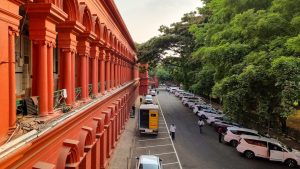

Regional Benches of the Supreme Court
Rajya Sabha member and Senior Advocate P Wilson has written to Union Law Minister RS Prasad urging the Government to introduce a bill so that Article 130 of the Constitution can be amended to provide for permanent regional Benches of the Supreme Court at New Delhi, Mumbai, Chennai and Kolkata. This is not the first instance where the solution to remedy the Supreme Court’s constantly escalating docket has been to increase the number of judges and create regional benches. In 1956, the size of the Supreme Court was increased from its original 8 to 11; in 1960, from 11 to 14; in 1977, from 14 to 17; in 1986, from 17 to 26; and in 2008, from 26 to 31.[1] However, analysis has suggested that merely increasing the number of judges will not affect the overall rate of disposal. The time taken per hearing will simply be adjusted (read: increased) as a result of the influx of new judges.[2]
What has constantly been overlooked are the structural issues associated with the problem of pendency in the Supreme Court. The first issue is the broad jurisdiction of the Supreme Court – it acts as a court of original jurisdiction on matters relating to fundamental rights, but is also the final court of appeals in India. While the Supreme Court was to act as the highest Constitutional court in the country, a majority of its time is now spent adjudicating appeals from subordinate courts and tribunals (with the maximum appeals coming from High Courts), in exercise of its special leave jurisdiction[3]. This special leave jurisdiction was originally intended to be invoked only in exceptional circumstances.[4] An empirical study of the workings of the Supreme Court[5] provides further insight into this issue. As part of the study, the workload of the Supreme Court was categorised based on subject matter. Criminal cases constituted the largest category of cases before the Supreme Court. Amongst the percentage of civil cases before the Supreme Court, the largest category was ‘service matters’. Constitutional matters, together with public interest litigation matters (PILs), constituted a paltry percentage (less than 10%) of the overall output of the Supreme Court.
What exacerbates this situation is the abysmal record of the Supreme Court in constituting five-judge benches to hear matters on substantial questions of law. The study found that two-judge benches were formed to hear almost 90 percent of the cases in their dataset, with three-judge benches being formed to hear most of the remaining cases. Five-judge benches were constituted to hear only a small share of the total number of cases before the Supreme Court. The study also found that a significant percentage of cases involving challenges to actions of the government or constitutionality of legislation were decided by two-judge benches. A similar pattern was observed in relation to PILs, with two-judge benches hearing over 71 percent of all PILs. [6]
Another important observation that came out of the study was the correlation between geographical proximity to the Supreme Court and appeal rate. It is not surprising that the among the appeals from High Courts, appeals from the High Court of Punjab and Haryana comprised a large portion of the total appeals, with no appeals from the High Courts of the North East. Moreover, these appeals formed 90 percent of the output of two-judge benches. The decisions of five-judge benches were primarily restricted to matters relating to the original jurisdiction of the Supreme Court.[7] The findings of another study confirms this argument: the probability of appeals to the Supreme Court made by appellants situated nearer to Delhi was considerably higher than those situated farther away.[8] In 2011, the four High Courts that were the closest to the Supreme Court were the ones with the highest appeal rates. Although these states comprised merely 7.2% of the total population, the appeals from these courts constituted 34.1% of the aggregate appeals to the Supreme Court. [9] Additionally, those with the means to reach the Supreme Court (such as the government) were also more likely to appeal to the Supreme Court.[10] The cost of engaging a senior advocate will also need to be considered while calculating the total cost of appeal.
The Supreme Court’s massive docket can also be attributed to the public’s perception of the Supreme Court. They view the Supreme Court as infallible and incorruptible, removed from the local relationships of power. Largely distrustful of the functioning of the subordinate courts and High Courts, they believe that the Supreme Court helps in policing and holding these lower courts accountable.[11] It then comes as no surprise that special leave petitions dominate the caseload of the Supreme Court. There are two categories of matters that come before the Supreme Court: ‘admission matters’ and ‘regular hearing matters’. Admission matters are those which the Supreme Court deliberates to admit for regular hearings. The time spent on these matters, which include special leave petitions, is two days out of the entire working week. The remaining three days are spent hearing regular hearing matters.[12] TheSupreme Court hardly dedicates any of its time in adjudicating matters concerning substantial questions of law.
Due to these reasons, there have been suggestions to separate the constitutional and appellate functions of the Supreme Court through the introduction of ‘regional benches’ of the Supreme Court. The constitutional division, dealing with Constitutional matters, would be located at Delhi, and the divisions handling appellate matters would be situated in different regions within the country.[13] The Law Commission of India has, on several occasions, called for the bifurcation of the Supreme Court into different divisions.[14] In 1986, the 95th Report of the Law Commission proposed the division of the Supreme Court into a (i) Constitutional division and (ii) legal division. The report also categorised which type of cases would appear before which division. Moreover, it stipulated that judges be assigned to a particular division within a short period of them getting appointed to the Supreme Court.[15] Thereafter, in 1988, the 125th Law Commission report reiterated the recommendations made in the 95th Law Commission report. The Law commission believed that splitting the Supreme Court into two divisions would make justice more widely accessible thereby significantly reducing expenses of litigants wishing to approach the Supreme Court.[16]
Echoing the sentiment of the previous reports, the Eighteenth Law Commission, in 2009, recommended the setting up of four Cassation Benches in the Northern region/zone at Delhi, the Southern region/zone at Chennai/Hyderabad, the Eastern region/zone at Kolkata and the Western region/zone at Mumbai. The function of these four Cassation Benches would be to handle appellate work arising from High Court orders/judgments of that particular region. The Law Commission also recommended the setting up of a Constitution Bench at Delhi to manage constitutional and other related issues.[17] This would aid in clearing the backlog of cases before the Supreme Court, while also allowing the Supreme Court to dedicate its time adjudicating matters of national importance and relating to important constitutional issues. This suggestion was also in the interest of litigants living in places distant from Delhi, whose right to justice as guaranteed under the Constitution, was being adversely affected.[18] In 2019, the Vice President of India, M. Venkaiah Naidu, strongly advocated in favour of the establishment of regional benches, a move he believed would bring the judiciary closer to the people. This way, litigants could also avoid bearing the expenses of travelling to Delhi. [19] In essence, justice is made more accessible.
Accessibility, however, can be a double edged sword. While the constitution of regional benches can make delivery of justice more efficient, it can also increase the volume of litigation. Taking the example of the Supreme Court itself, a study conducted demonstrated that the transformation in the workload of the Supreme Court, one of the world’s most accessible superior courts, was solely attributed to access.[20] If regional benches become a reality, the ensuing proliferation in the volume of litigation cannot be avoided. With reduced costs involved in the litigation process and easier access, the introduction of regional benches could worsen the pendency.
Because of its immense caseload, another problem that the Supreme Court is grappling with is the problem of inconsistency in judgments. As the highest judicial authority in the country, the Supreme Court has an obligation to deliver judgments which provide certainty on a specific legal matter. However, as previously mentioned, a majority of the cases that come before the Supreme Court are decided by two-judge, or three-judge benches. In a study on the functioning of the Supreme Court, the author has observed that these benches have been delivering poorly reasoned decisions, frequently disregarding established precedent, and contributing to a growing body of conflicting precedent. In other jurisdictions, lawyers, based on their knowledge of precedent (which is strictly followed), commonly advice clients on whether their case would be successful before courts. In India, however, this body of contradicting precedent is encouraging more and more parties to litigate than to settle out of court. The author has pointed out how this has created a vicious cycle: the large docket of the Supreme Court prevents overworked judges from spending sufficient time to carefully consider cases, leading to a corpus of illogical judgements and unsettled law, and in turn leading to more and more cases being filed before the Supreme Court.[21] The addition of regional benches could only aggravate the issue. With more benches (which are also located in different regions of the country), there comes more litigation, and in turn, a larger body of unpredictable legal principles.
In fact, back in 2010, the Supreme Court had rejected the demand for regional benches, believing it would impair the unitary character of the country.[22] The concept of regional benches, like any other novel idea, has its fair share of advantages as well as disadvantages. It is imperative that the Supreme Court, in light of its ever-escalating docket and other allied concerns, weighs these pros and cons and decides on a course of action that will make its caseload more manageable.
(Pooja Murty was a consultant with DAKSH)
[1] Robinson, N., 2013. Structure matters: The impact of court structure on the Indian and US Supreme Courts. The American Journal of Comparative Law, 61(1), pp.173-208.
[2] Hemrajani, R. and Agarwal, H., 2019. A temporal analysis of the Supreme Court of India’s workload. Indian Law Review, 3(2), pp.125-158.
[3] Article 136 of the Indian Constitution
[4] Khaitan, Tarunabh. “The Supreme Court as a Constitutional Watchdog.” In Tarunabh Khaitan,‘The Supreme Court as a Constitutional Watchdog’(2019) 721 Seminar, pp. 22-28. 2019.
[5] Chandra, Aparna, William HJ Hubbard, and Sital Kalantry. “The Supreme Court of India: An Empirical Overview.” Forthcoming in Rosenberg, Gerald N., Sudhir Krishnaswamy, and Shishir Bail, eds., The Indian Supreme Court and Progressive Social Change (Cambridge, 2019) (2018).
[6] Id.
[7] Supra note 6.
[8] Supra note 2.
[9] Mishra, S., 2017. Regional Benches of the Supreme Court of India-The Path Ahead. Christ University Law Journal, 6(1), pp.57-74.
[10] Supra note 2.
[11] Id.
[12]https://www.hindustantimes.com/columns/the-supreme-court-does-not-need-more-judges/story-GuWVG6vKXYP02aq3QGtC6N.html (last accessed November 05, 2019)
[13] Supra note 5. Also see https://pib.gov.in/newsite/PrintRelease.aspx?relid=192590 (last accessed October 31, 2019).
[14]https://indianexpress.com/article/explained/idea-of-regional-sc-benches-and-divisions-of-the-top-court-6036692/ (last accessed October 31, 2019).
[15] Supra Note 10.
[16] Id.
[17] See 229th Law Commission Of India, Need For Division Of The Supreme Court Into A Constitutional Bench At Delhi and Cassation Benches In Four Regions At Delhi, Chennai/Hyderabad, Kolkata And Mumbai (2009) http://lawcommissionofindia.nic.in/reports/report229.pdf (last accessed November 04, 2019)
[18] Ibid. See also Mishra, S., 2017. Regional Benches of the Supreme Court of India-The Path Ahead. Christ University Law Journal, 6(1), pp.57-74.
[19] https://pib.gov.in/newsite/PrintRelease.aspx?relid=192590 (last accessed October 31, 2019).
[20] Supra note 2.
[21] Id.
[22]https://www.thehindu.com/news/national/Supreme-Court-again-says-lsquonorsquo-to-regional-Benches/article16815858.ece (last accessed October 31, 2019).
[ReviewDisclaimer]
Pooja Murty
RECENT ARTICLES


Conduct of Insolvency Professionals: To whom so ever it may concern

Civil Appeals at Karnataka High Court

Ayodhya Development Plan seems to have ‘no plans’ for its Courts

-
Rule of Law ProjectRule of Law Project
-
Access to Justice SurveyAccess to Justice Survey
-
BlogBlog
-
Contact UsContact Us
-
Statistics and ReportsStatistics and Reports
© 2021 DAKSH India. All rights reserved
Powered by Oy Media Solutions
Designed by GGWP Design